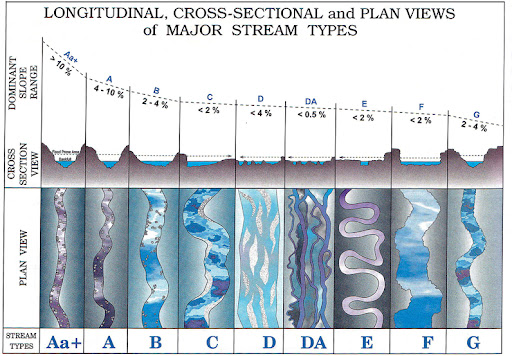Stream and River Classification: Hydrology, Morphology, and Ecology
1/33
There's no tags or description
Looks like no tags are added yet.
Name | Mastery | Learn | Test | Matching | Spaced |
|---|
No study sessions yet.
34 Terms
Channel-forming flow
The flow that shapes channel dimensions over time, typically bankfull discharge (recurs every 1.5-2 years); responsible for forming and maintaining channel morphology.

Lane's Balance Concept
Conceptual model showing sediment-water balance: QsD ∝ QwS. If sediment supply or size increases, slope must steepen or discharge must decrease (aggradation). If discharge or slope increases, erosion (degradation) occurs.
Stream/River Classification Purpose
Categorizes rivers based on morphology, hydrology, or ecology for management and comparison.
Rosgen Classification
Descriptive system using slope, entrenchment, width/depth ratio, sinuosity, and channel pattern; classifies streams as types A-G.

Montgomery & Buffington Classification
Process-based system defining channels as colluvial, cascade, step-pool, plane-bed, or pool-riffle types.
Pros of Classification
Provides standardized comparison, helps predict behavior, aids in restoration and management.
Cons of Classification
Can oversimplify variability, ignore underlying processes, and be descriptive rather than predictive.
EPT Taxa
Ephemeroptera (Mayflies), Plecoptera (Stoneflies), Trichoptera (Caddisflies); groups used to assess water quality.
Ephemeroptera (Mayflies)
Have 3 tails, abdominal gills, and are very sensitive to pollution.
Plecoptera (Stoneflies)
Have 2 tails, thoracic gills, and require cold, well-oxygenated water.
Trichoptera (Caddisflies)
Often make cases from sand/plant materials; moderately pollution sensitive.
% EPT Formula
% EPT = (Number of Ephemeroptera + Plecoptera + Trichoptera) / Total Individuals × 100.
Hilsenhoff Biotic Index (HBI) Formula
HBI = Σ(ni × ai) / N, where ni = # of individuals in taxon i, ai = pollution tolerance (0-10), N = total individuals. Lower HBI = better water quality.
Pacific Salmon Species
Chinook, Coho, Sockeye, Pink, and Chum (genus Oncorhynchus).
Pacific Salmon Traits
Anadromous (spawn in freshwater, mature in ocean), semelparous (die after spawning), depend on cold, clean, connected water systems.
Pacific Salmon Threats
Dams blocking migration, habitat loss, sedimentation, overfishing, and warming/climate change.
Pacific Salmon Management
Fish ladders, dam removal, hatchery reform, habitat restoration, flow and temperature regulation.
River Continuum Concept (RCC)
Model describing predictable changes in energy sources, organisms, and nutrients from headwaters to mouth.
Headwaters (RCC)
Shaded, rely on allochthonous inputs (leaf litter); shredders and collectors dominate.
Mid-order Streams (RCC)
Increased light and autochthonous production (algae); grazers/scrapers dominate.
Lower Reaches (RCC)
Deep, turbid, dominated by fine particulate organic matter (FPOM); collectors dominate.
RCC Pros
Simple framework linking energy and biota longitudinally along rivers.
RCC Cons
Assumes undisturbed systems; ignores floodplain complexity and human influence.
Manning's Equation
V = (1/n) × R^(2/3) × S^(1/2); used to calculate velocity in open channels, where n = roughness, R = hydraulic radius, S = slope.
Manning's Discharge Equation
Q = V × A; discharge equals velocity times cross-sectional area.
Manning's Coefficient Effect
Higher roughness coefficient (n) → lower flow velocity.
Rosgen Classification Levels
Level I-IV: (I) broad type, (II) field measurements, (III) process validation, (IV) monitoring and verification.
Rosgen Example
C-type stream = low gradient, meandering, floodplain connected; B-type = moderate gradient, confined.
Marine-Derived Nutrients (MDN)
Nutrients (mainly N and P) brought from ocean to freshwater via spawning salmon; enhance ecosystem productivity.
Importance of MDNs
Support aquatic insects, juvenile fish, birds, and riparian vegetation via carcass decomposition.
Decline of MDNs
Fewer salmon returns reduce nutrient enrichment and ecosystem fertility.
Flow Regimes
Perennial (year-round), intermittent (seasonal), ephemeral (after storms).
Channel Patterns
Straight (high energy), meandering (moderate slope), braided (high sediment load), anastomosing (multiple stable channels).
Process-Based Stream Types
Colluvial, cascade, step-pool, plane-bed, and pool-riffle streams, classified by sediment and flow dynamics.